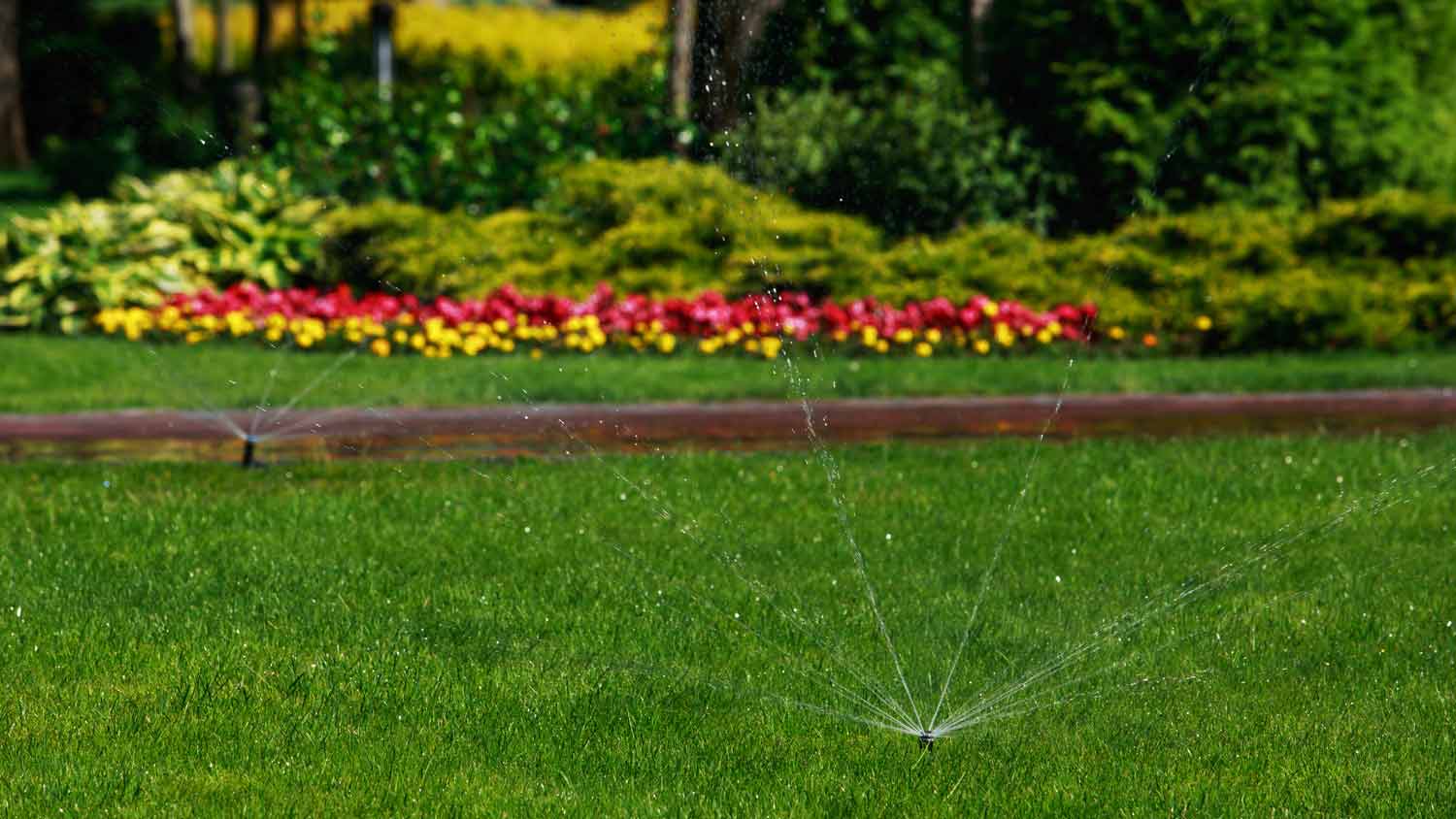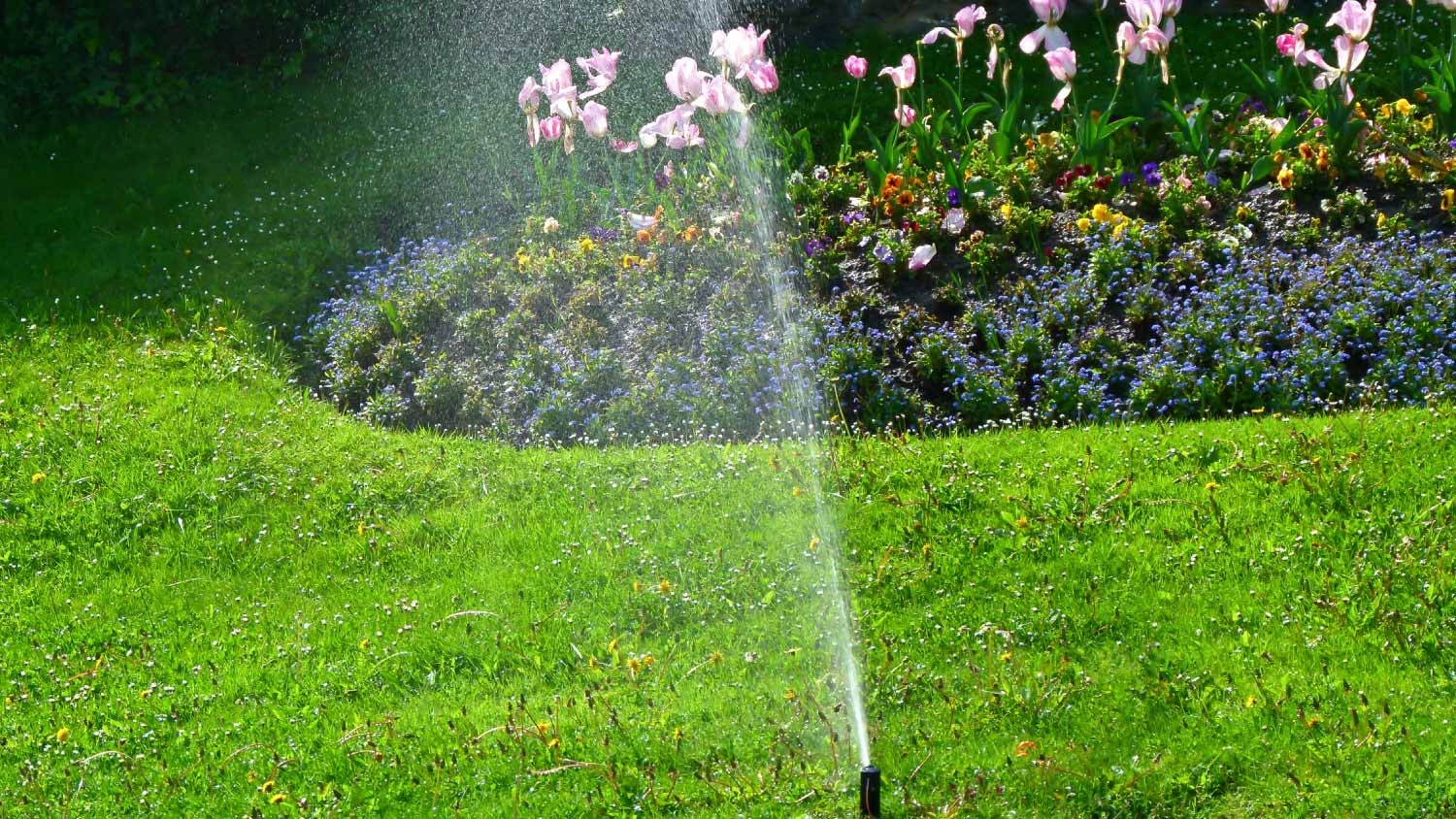How to Repair a Sprinkler Line in 8 Easy Steps
It’s a bit of a dirty job—but not a hard one, so long as you’ve got the right tools


- Garden trowel
- Garden gloves
- Cleaning rags
- Hacksaw or pipe cutter
- Screwdriver
- Band clamps
- One or two coupling inserts for your sprinkler system
- New tubing to match your sprinkler system (PVC, polyethylene, or metal)
- Stake flags (optional)
When it comes to keeping your landscaping looking lush and lively, your trusty sprinkler system has your back—unless, of course, a line is broken.
Given the average cost of installing a sprinkler system—which can run upwards of $3,500, depending on what type of sprinkler you have—a broken line might strike fear into the hearts of some homeowners. Fortunately, that worry is misplaced, because repairing a sprinkler line is actually a relatively simple DIY project. Even beginner DIYers can get it done in just a few hours. Let’s go over how to repair a sprinkler line yourself.
Before You Repair a Sprinkler Line
Besides your sprinkler line, there may be important lines, like sewer lines or utility lines, underground on your property. While sprinkler lines are generally easy to repair, those other types of lines are not, and repairs usually require lots of time and professional help (plus, inconveniences like not being able to flush your toilet for an uncomfortable amount of time), so it’s important to figure out where the underground lines are before you head out into your yard with a trowel to start digging.
If you’re not sure where your sewer and utility lines are, you can call 811 for help finding them before you start repairing your sprinkler line. Once that’s done and you feel confident you’re not going to cause any other damage in the process, it’s time to get digging.
Find the Leak
The first step to fixing a sprinkler line leak is to sniff out the leak. Since you’ll be digging into your lawn to perform the repair, it’s important to get the best possible sense of where the damage is. Start by turning on your sprinkler system and assessing your yard for the following signs of a leak in your sprinkler line:
Sounds of running water underground
Water spraying or spouting
Water puddling or pooling in your yard
A sprinkler head, or series of them, that isn’t working properly
If a series of sprinkler heads aren’t spraying at their full pressure, you’ll find the leak between the last working sprinkler head and the first defective one. You may need to run your system for a while to figure out exactly where the leak is. Once you find it, mark the leak with a stake flag, rock, or other object to make sure you remember where it is.
Then, turn the water off and wait for a few minutes for all of it to flush out of the system. (Otherwise, you risk getting sprayed once you start working!)
Dig Out the Sprinkler Line
Once you have a good sense of where the leak is, dig up the sprinkler line so you can repair it. Dig out a large, regular square of grass and soil with about two to three inches of dirt underneath it so the grass can re-root and continue to grow once you place the piece back over the repaired pipe.
Use a small hand trowel for this project, since a large shovel could puncture the sprinkler line and damage it even further. Once you’ve dug out the top square of grass and dirt and removed it (using both hands or even the help of a friend), you can begin digging around and under the sprinkler line to fully expose it. Be sure to reserve that square of grass and dirt to replace later!
Once the pipe is fully exposed, use a wet cloth to clean off any remaining dirt so you can spot exactly where the leak is.
Cut Out Broken Line
 Photo: Michael Vi / iStock / Getty Images Plus / Getty Images
Photo: Michael Vi / iStock / Getty Images Plus / Getty ImagesNow that the damaged part of the pipe is visible, use a hacksaw or pipe cutters to snip out that part, leaving an open pipe coming out of the ground on either end. If you’re using a saw, use smooth, consistent strokes to create a relatively smooth edge, which will make the rest of the repair easier.
Remove the damaged portion of the pipe and discard it.
Place Band Clamps on Either End of the Piping
Next, take a band clamp—an adjustable metal clamp that can be tightened to fit a variety of piping sizes—on each remaining edge of the sprinkler line coming from the ground. Don’t tighten the clamps yet.
Fit the Coupling on the Pipe(s)
Next up, you’ll insert one side of the coupling into one end of the remaining undamaged pipe. If your pipes are PVC or polyethylene, heating the pipe first with a hand torch can make it more malleable and ease the process—but be careful not to use too much heat for too long, which could melt your pipes.
Depending on the amount of pipe you had to cut out to fix the damage, you may need to repeat this step on the other remaining pipe as well, so that you’ll have two couplings coming from either side of the remaining pipe in the ground—you’ll fit these together using a stretch of new piping cut to fit the gap. (Don’t forget to put band clamps onto the stretch of new pipe, too.)
If the damaged area is small enough—say, three inches or less—you may be able to simply insert the same coupling into the other end of the remaining sprinkler line, bridging the gap and creating a new, undamaged pathway for the water.
Tighten the Band Clamps

Once you’ve repaired the damage with new piping and couplers, tighten the band clamps down to help ensure there won’t be a future leak. To do so, you’ll need to use a screwdriver. Remember, you’ll be tightening between two and four band clamps, depending on the extent of your damage, so don’t accidentally overlook any of them.
Test the Sprinkler System
Before you cover your newly repaired sprinkler line with dirt once again, test it to make sure everything’s back in working order. You don’t want to have to go digging for your pipe all over again if the repair didn’t take.
To test your sprinkler system, turn it on and check to see if the newly repaired portion of the sprinkler line is still leaking. If there’s no leak, congratulations: You repaired your sprinkler line. If you see a leak, the problem might be a loose band clamp or an ill-fitting coupler.
Once you’ve completed the test, turn your water back off.
Bury the Sprinkler Line
Once you’ve tested the sprinkler system, it’s time to bury the line and get your yard back to looking good as new. Add dirt under the sprinkler line to physically support it so that pressure from above doesn’t cause it to bend or break over time.
After filling in the dirt below and around the sprinkler line, add more on top until your reserved piece of grass and soil can fit into the neat square you’ve left for it. And just like that, your sprinkler line is repaired and ready to get back to its important job of keeping your lawn looking green and gorgeous.
How to Prevent Broken Sprinkler Lines
Diligent maintenance and smart lawn care practices go a long way toward preventing broken sprinkler lines.
Winterize your sprinkler system before the first freeze of the year.
Don’t dig unless you’ve marked off exactly where your sprinkler lines are.
Don’t drive heavy machinery over your sprinkler lines.
Get annual inspections to ensure everything is in working order and catch minor problems before they become big, pipe-breaking ones.
Don't neglect your sprinkler system maintenance, such as annual cleanings and inspections. These upkeep tasks can help prevent costly issues like clogged pumps and leaking pipes.
DIY Sprinkler Line Repair vs. Hiring a Professional
Repairing a sprinkler line isn’t particularly complicated—but it can be time-consuming and messy (prepare to get at least a little wet). If you’d rather spend your day doing something a little less dirty and have the extra cash to spare, hiring a local sprinkler professional shouldn’t set you back too much more than DIYing it: The cost of sprinkler repair is about $75 an hour for labor, which means most people end up spending about $270 to repair a sprinkler system.
Frequently Asked Questions
Yes, a sprinkler system can leak when turned off. If this happens to you, it may indicate that your valves (which stop the supply of water from the source) are leaky or that the water hasn’t yet finished draining out of the system. In this latter case, you’ll likely notice the leak coming from the lowest sprinkler head, since that’s where gravity will bring the water to drain.
Sprinkler pipes can leak for all sorts of reasons, including damage like being accidentally stepped on or punctured by garden tools. Systemic reasons can also be to blame, like broken or damaged O-rings and connections. Your sprinkler pipes might also leak if they weren’t properly installed in the first place or if the above-ground valves have gone bad.
The main sprinkler valve is usually located in an easy-to-access location close to the house and may include one or two backflow valves that help reduce the risk of water flowing backward toward the source. If you’re still unsure where your main sprinkler valve is located, consult your owner’s manual for full details.





















